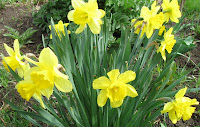

How to prepare the garden for winter:
BULB PLANTING
BULB PLANTING
For the best chance of repeat bloom in subsequent years, choose a site in full sun that doesn't get much summer water. Bulbs that naturalize reliably include Allium, Daffodils, Scilla and species tulips. Feed with a fertilizer formulated specifically for bulbs. Squirrels like Tulips, use a piece of chickenwire to cover the soil and then add a thick layer of mulch.
ROSES, SHRUBS & TREES
Plant container roses and prune your hybrid tea roses. Start preparing your roses for winter:Start putting mulch around each of your rose plants after the first frost. You'll want to build up a decent sized mound around the plant, roughly 12 inches above its base.Water your rose plants as you normally would. They need plenty of water to prepare for a long winter.Set up a wire fence around some of your more delicate roses. The fence should be a circle that surrounds the plant and extends several inches above the top of it. Fill the wire fence with leaves. These leaves will insulate the plant from the cold and also protect it from a sudden warm day in the winter. Leaves are the best way to insulate your roses because they allow the plant to breath and don't trap moisture.
DIVIDE AND MOVE PLANTS
Consider moving some plants around now:Moving or dividing perennials in the autumn is a great way to reduce your work next spring.
The cool, moist weather is an ideal time for perennial roots to become well established,even in cold-winter regions. Division not only maintains the health of your perennials, but it's also an easy way to propagate your plants so that you’ll have more coverage next season.
The cool, moist weather is an ideal time for perennial roots to become well established,even in cold-winter regions. Division not only maintains the health of your perennials, but it's also an easy way to propagate your plants so that you’ll have more coverage next season.
PLANT & AMEND SOIL!!!
Fall is a very good time to plant perennials such as Peonies, Coneflower and black-eyed Susan. You can also plant garlic now for next years harvest. Plant container and balled-and-burlapped trees, fruit trees, shrubs and vines.
Spread a thick layer of compost, seaweed (kelp) or composted manure and then add a thick layer of mulch around shrubs and trees but do not place mulch too close to the plant’s trunk. Mulch helps control weeds, provides insulation for the roots during cold weather, and helps keep the soil moist.
Spread a thick layer of compost, seaweed (kelp) or composted manure and then add a thick layer of mulch around shrubs and trees but do not place mulch too close to the plant’s trunk. Mulch helps control weeds, provides insulation for the roots during cold weather, and helps keep the soil moist.
Fall is a good time to fertilize both lawn and garden. Work some bonemeal into the soil, especially around tress and shrubs for good root development.
It’s a good idea to water your garden thoroughly before the ground freezes. Even with snow,
winter can be very dry and harsh for many trees and shrubs.
winter can be very dry and harsh for many trees and shrubs.
DIG OUT
Edge the perennial beds. Continue dead-heading any daisy-flowered perennials, especially Echinacea, Rudbeckia and False Sunflower (Heliopsis). These will continue flowering for weeks if you prevent the flowers from forming seeds. If you have Gladiolus, this is the time to dig the corms up and to lift your Dahlias too. Divide a clump of Chives and some bring indoors for fresh Chives in the coming weeks.
Pull out your annuals and throw them in the compost. Cut back your perennials and put the foliage in the compost as long is it's not diseased. Try to keep the fallen leaves raked off the lawn. Put them in the compost, shredding them first, using your lawnmower or mix them really well as they tend to compact. Give your compost pile a final turning.
Pull out your annuals and throw them in the compost. Cut back your perennials and put the foliage in the compost as long is it's not diseased. Try to keep the fallen leaves raked off the lawn. Put them in the compost, shredding them first, using your lawnmower or mix them really well as they tend to compact. Give your compost pile a final turning.
GARDEN EQUIPMENT
It's time to store your watering hoses inside. Remember to drain them first so they don't freeze and split.Clean and oil your tools so they won't rust over the winter.
Reduce feeding houseplants and do not feed dormant houseplants.
Reduce feeding houseplants and do not feed dormant houseplants.
WINTER PROTECTION
Try using evergreen boughs over your shrubs to provide winter protection. They can be forced into the ground before the ground freezes, draping their branches over the shrubs.
Bring in any annual Geraniums! Potted, in a sunny spot they will bloom all winter. Or hang them upside down (with the soil removed) in a cool spot such as the garage or basement.
Trees can be protected from rodent damage by placing a cylinder of ¼-inch mesh hardware cloth around the trunk. The cylinder should extend 5 cm below the ground line for mice and 40 cm above the anticipated snow line for rabbit protection.
Bring in any annual Geraniums! Potted, in a sunny spot they will bloom all winter. Or hang them upside down (with the soil removed) in a cool spot such as the garage or basement.
Trees can be protected from rodent damage by placing a cylinder of ¼-inch mesh hardware cloth around the trunk. The cylinder should extend 5 cm below the ground line for mice and 40 cm above the anticipated snow line for rabbit protection.





















































